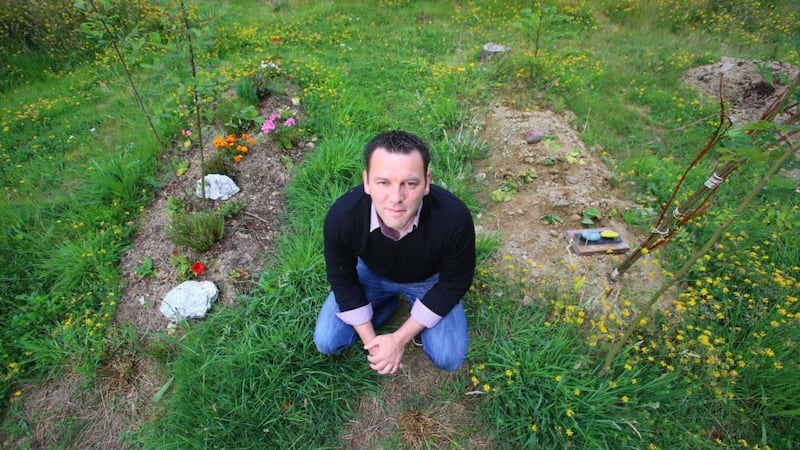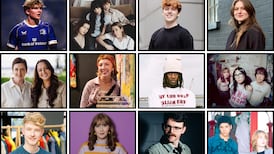In the middle of Dublin a group of friends and family gather to tell funny, moving stories and sing songs while a slideshow of photographs runs behind them. They’re celebrating the life of a much-loved woman who has died after a long illness. A humanist celebrant unobtrusively introduces and encourages the speakers. Contributions are often spoken directly to the deceased. There’s a minute’s silence when people are encouraged to pray if they wish.
People laugh. Speakers struggle with tears. At the end of each contribution there’s a round of applause. The congregation is colourfully dressed, some in T-shirts and summer dresses. The celebrant is formally clad, but in light colours. The most conspicuously dark-suited people are the funeral directors. At the end, everyone circles around the wicker coffin as they leave, in a gesture of respect. There’s no incense. No prayers for the dead. There is no god at this funeral.
This year Brian Whiteside of the Humanist Society of Ireland expects there to be more than 100 humanist funerals in Ireland. He lists a number of prominent people who have had such send-offs in recent years, including the journalist Mary Raftery and the politician Justin Keating. When Whiteside started officiating, in 2006, he performed four funerals. "In 2007 it went up to 12. Then last year we did 78. This year we expect to do over 100."

The Irish do funerals well. Everyone seems to agree on this. But Irish funerals are changing. John Kirwan of Kirwans Funeral Directors in north Dublin, who has been in the business for more than 50 years, recalls when every funeral he did was Catholic. He also recalls a time, before embalming, when coins were placed on the deceased's eyes, a Bible was put under the chin (to keep mouth and eyes shut) and a bow was tied around their head.
As long as Séamas Griffin, the current managing director of Kirwans, has been in the business, bodies have been embalmed. (“We even do make-up and dye hair. The details are important to people.”)
In their display room he shows me Irish oak coffins with detailed inlays beside more ecologically friendly wicker caskets. In a display case are the urns. Nowadays about 30 per cent of people in Dublin are cremated when they die. “A decade ago that was only 5 per cent,” says Griffin. This is partially, he says, because older burial plots are filling up, but it’s also because people are beginning to appreciate the romance of having their ashes scattered in places that were significant to them.
Community
In Ireland funerals have always been a community phenomenon. That said, there's much lower attendance at funerals now in the city, though Griffin acknowledges that this is different for his country colleagues. "Ten years ago at removals in Fairview [in Dublin] you wouldn't be able to get into the place, whereas now you'd have the immediate family and friends. I think our attitude in the cities is becoming a little like the UK. It becomes a private thing."
Yet some old traditions are making a comeback. The wake, for example. This is partially, says Griffin, because there aren’t enough priests in Dublin to accommodate removals, but largely because people find these events cathartic. “It’s not like the old myth of people swigging out of bottles of poitín and whisky around the open coffin. People arrive at the house to pay their respects. They talk to the family and talk to the deceased and have a cup of tea and a chat . . . They’re not there until 4am.”
Griffin grew up working for his family's undertaking business in Ashbourne, Co Meath. "People say, 'Was it like that programme Six Feet Under?' " he says with a laugh. "And I say, 'Yeah, that type of thing.' I was about 14 when my old man started bringing me out. We could be at home, having a family dinner Christmas day, and the doorbell would ring and someone would say, 'Tom has just passed,' and they'd need help and advice. They'd be brought into the sitting room and would sit down, and you'd sit there and go through the arrangements.
“As a teenager my dad might wake me in the middle of the night. We’d put a coffin in a hearse and travel to the house where the deceased person was. We’d often know the people. So you’d take your time and sit down and sympathise and take the body to the hospital or funeral home or embalming theatre or wherever.”
Undertakers in Ireland are still largely part-time family businesses. American companies attempted to make inroads in the Irish market in the 1990s, but they “couldn’t understand it here”, says Griffin. “Colleagues overseas are often aghast at how the Irish celebrate the passing of a loved one. ‘You’re having an open casket?’ Americans and English people can’t understand why it’s absolutely automatic that the coffin will be open and that it will be brought to the family home. It’s such a great thing, and this is why we’re good at celebrating death, because we actually get involved with our loved ones.”
The biggest change in recent years, says Griffin, is that people are demanding choice. The Dublin archdiocese has begun consulting undertakers about how to address people’s changing needs. “It’s the first time the church has recognised the other stakeholders in this part of life’s journey. I suppose it’s only in the last 10 or 15 years that people are copping on that they can ask for something different, that they don’t have to go to church tomorrow night and have a burial the next day. That they don’t have to go to church at all.”
New businesses have emerged. Jennifer Muldowney, author of Say Farewell Your Way, spent a few years working as a funeral planner, often with people who wanted to plan their own funerals. Irish people have traditionally seen funerals as communal experiences for those left behind. But increasingly, says Muldowney, people want to reflect the individuality of the person who has died.
“Some people find [the idea of planning your own funeral] morbid,” she says. “I lived in the States for two years, so maybe it’s Americanisation, but what I’m trying to do is focus on the life-celebration aspect of the funeral – a sense of camaraderie and community.
“I think we’ve gone a bit into the cookie-cutter funeral in this country, where a person passes away and no thought is even given as to what religion they were or what they gave their life to. We choose the local undertaker, because they buried Aunt Mary, and the local church, and that’s it: the person is cold in the ground. I’ve had people say two or three weeks after a funeral, ‘That wasn’t dad. It was all so stale.’ I’m not saying let’s dance on people’s graves, but it should be more personalised, and more thought should go into it.”
There are, she says, practical reasons to think about these things in advance. “I know families who’ve had two funerals for the one person, because they’ve disagreed so much. If there’d been some guideline set by the person that had passed away there might have been a way to turn those two funerals into one.”
Muldowney recalls a “preplan” she did for one young woman. “She was an atheist. She didn’t know if she’d ever marry her partner, and her parents were split up. So she said she needed to put guidelines down because, as she said herself, ‘shit would hit the fan’ if she didn’t.”
Green coffins
Colin McAteer is a funeral director who has expanded into selling "green coffins" – ecologically sound wicker coffins – and providing, in a meadow in Co Wexford, an ecologically friendly natural burial ground.
“Four years ago people were telling me I was a wee bit cracked trying to sell willow coffins and whatnot. Now people are getting used to seeing them, and they’re becoming a norm. The natural graveyard came because I always had this thing where I didn’t want to be buried under two tonnes of marble and concrete. The idea here is that the ground has a second use. It’s a really nice thing for families coming back to visit the graveyard, because it’s not just a graveyard: it’s a walk around a wild-flower meadow, and people can sit on log benches and do what they want.”
Of course, not everyone wants change. “One funeral director told a family that their father would have to be taken out in six months and buried in a proper graveyard. There was another situation where a family approached me because an undertaker wouldn’t take them to our graveyard. I stood in and did the funeral myself.”
So far 26 people have been buried in McAteer’s natural burial ground, and more than 100 others have booked plots. “People want choice,” he says. “Death isn’t as taboo a subject as it used to be, and people now talk about it.”
Cost, he says, is increasingly an issue. Funerals cost €4,000-€6,000 on average. During the boom, stories of horse-drawn carriages and glass coffins abounded. Some people who couldn’t really afford to do so ran up huge debts. “Nowadays people do look for value,” says McAteer.
About 50 per cent of those buried in McAteer’s graveyard have Catholic funerals. The percentage is much higher nationally. Brian Whiteside believes that this is more to do with convenience than with faith. Even today there are no options for nonreligious people who want to be buried in Donegal.
“We’ve written to the Government about that,” he says. The problem, he says, is that people don’t think about their own funerals until it’s too late. “So it’s sort of a panic decision. Somebody dies and, goodness, what do you do? You go to the undertaker, and the easy option is to not rock the boat. You go to the church, you press the button and it happens. It has been a one-size-fits-all approach. The way those milestones of life were celebrated was always in a religious context, and that suited religious people very well. Up to recently there was no choice. There is now.”
However much things change, Séamas Griffin thinks the Irish approach to funerals will endure. “I remember dressing a body in the hospice when I was about 15, and a nurse was with me,” he says. “She was saying, ‘Now, Paddy, here we go, we’re going to put a shirt on. We’ll put a Windsor knot on you, Paddy.’ And I realised that, to her, this was still the man that she was dealing with the day before and probably six months before. He was still Paddy. And I think that all the time now. It’s a good way of thinking for me to get through my job. It’s not a body. We don’t see it that way.”











